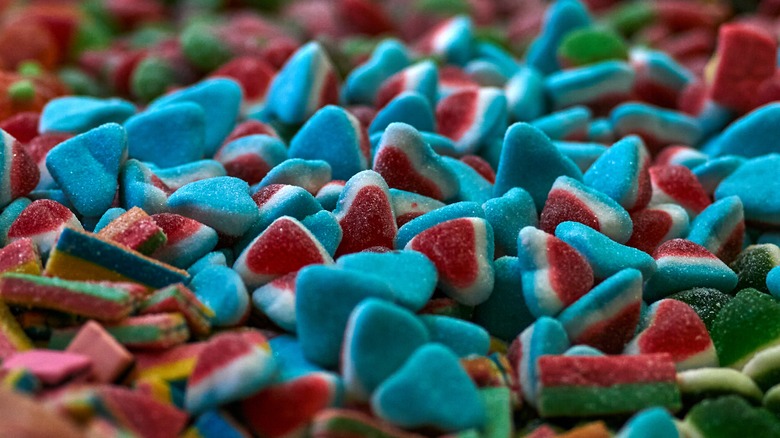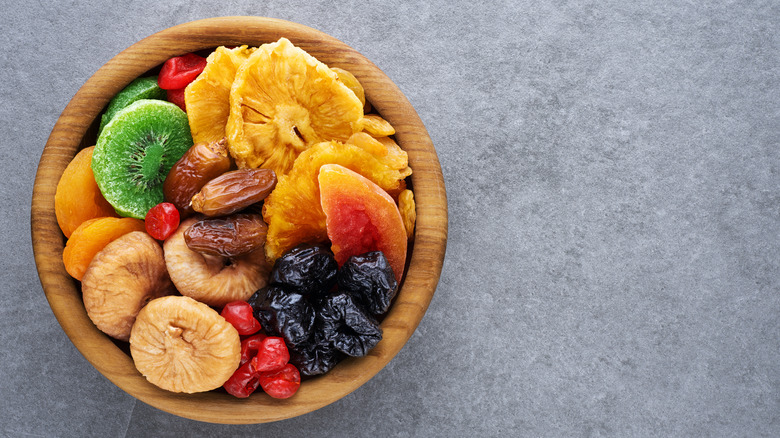What Does 'Made With Real Fruit' Mean For Gummy Snacks?
As a healthier diet continues to be a rising priority for consumers around the world, candy companies have started to launch more healthy snacks for consumers that rival their artificially-flavored counterparts. "Made with real fruit" gummy snacks are no exception, as these sweets highlight the use of natural ingredients as part of their marketing. This has proven to be an effective strategy, and some parents have even admitted that the labels of these snacks entice them to replace actual produce from their diets. But, while convincing, the use of "real fruit" in gummies does not offer the same amount of vitamins, fiber, and minerals found in their fresh counterparts — and it all comes down to the processing of the snacks.
If listed on the packaging, the term "made with real fruit" means an item contains fruit products as part of its ingredients. These products can range from actual fruit parts to concentrate, puree, or juice. While the latter offers manufacturers higher levels of sugar for lower amounts of volume, the pulping and heating processes these products go through actually remove most of the benefits of fresh fruit. On top of that, the FDA does not consider "made with real fruit" an implied nutrient content claim, and in turn does not regulate the statement very closely.
This allows both the quantity and quality of the fruit contents in various gummy snacks to vary wildly, and the actual percentage of real fruit in a product may not always be clear from the packaging.
'Made with real fruit' gummies are not all that they seem
"Made with real fruit" gummy snacks have drawn criticism for years due to their misleading labels. In 2015, Aliza Atik and Winnie Lau sued the food company Welch's over the phrase, arguing that the "made with real fruit" label deceived customers into believing the gummy snacks were a healthy alternative to actual produce. This would not be the first and only time the company received legal action over their misleading advertising, as class action lawsuits were filed against Welch's gummy snacks in 2017, 2020, and 2022.
The ingredients list for any food item is usually listed by descending order, based on the ingredients' prevalence in the product. This means ingredients closer to the beginning of the list are more abundant than those that are listed further down. But, even if a gummy snack product uses fruit as its primary ingredient, that does not guarantee these are much better than artificial candy snacks — and in fact, most "made with real fruit" candies offer about as much calories and sugar as regular gummies.
Dried fruits are a versatile alternative to fruit gummies
While "made with real fruit" gummy snacks pale in comparison to the health benefits of fresh produce, that does not mean people looking for healthier snack options have to abandon the concept of chewy, bite-sized fruits. Unlike their gummy counterparts, dried fruits retain much of their nutritional value during the dehydration process, and can be found in most grocery stores in a variety of sizes and flavors such as bananas, apricots, and apples.
Research notes these snacks contain high concentrated levels of fiber and antioxidants, which may aid in digestion and lower the risk of heart disease, diabetes, and certain cancers. On top of that, studies have shown that dried fruits like raisins can offer a surprising energy boost that rivals commercial sports supplement snacks.
These dried fruit goodies do not come without downsides, as some varieties are sold with added sugars that may defeat the purpose of a low-sugar, low-calorie snack. Other than that, dried fruits remain the healthier alternative to "made with real fruit" gummy snacks.



